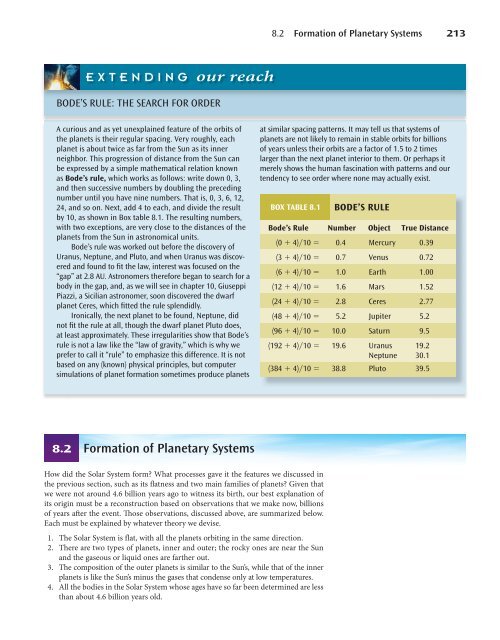Chapter 8
Chapter 8
Chapter 8
Create successful ePaper yourself
Turn your PDF publications into a flip-book with our unique Google optimized e-Paper software.
E XTENDING our reach<br />
BODE’S RULE: THE SEARCH FOR ORDER<br />
A curious and as yet unexplained feature of the orbits of<br />
the planets is their regular spacing. Very roughly, each<br />
planet is about twice as far from the Sun as its inner<br />
neighbor. This progression of distance from the Sun can<br />
be expressed by a simple mathematical relation known<br />
as Bode’s rule, which works as follows: write down 0, 3,<br />
and then successive numbers by doubling the preceding<br />
number until you have nine numbers. That is, 0, 3, 6, 12,<br />
24, and so on. Next, add 4 to each, and divide the result<br />
by 10, as shown in Box table 8.1. The resulting numbers,<br />
with two exceptions, are very close to the distances of the<br />
planets from the Sun in astronomical units.<br />
Bode’s rule was worked out before the discovery of<br />
Uranus, Neptune, and Pluto, and when Uranus was discovered<br />
and found to fi t the law, interest was focused on the<br />
“gap” at 2.8 AU. Astronomers therefore began to search for a<br />
body in the gap, and, as we will see in chapter 10, Giuseppi<br />
Piazzi, a Sicilian astronomer, soon discovered the dwarf<br />
planet Ceres, which fi tted the rule splendidly.<br />
Ironically, the next planet to be found, Neptune, did<br />
not fi t the rule at all, though the dwarf planet Pluto does,<br />
at least approximately. These irregularities show that Bode’s<br />
rule is not a law like the “law of gravity,” which is why we<br />
prefer to call it “rule” to emphasize this difference. It is not<br />
based on any (known) physical principles, but computer<br />
simulations of planet formation sometimes produce planets<br />
8.2 Formation of Planetary Systems<br />
How did the Solar System form? What processes gave it the features we discussed in<br />
the previous section, such as its fl atness and two main families of planets? Given that<br />
we were not around 4.6 billion years ago to witness its birth, our best explanation of<br />
its origin must be a reconstruction based on observations that we make now, billions<br />
of years aft er the event. Th ose observations, discussed above, are summarized below.<br />
Each must be explained by whatever theory we devise.<br />
1. The Solar System is flat, with all the planets orbiting in the same direction.<br />
2. There are two types of planets, inner and outer; the rocky ones are near the Sun<br />
and the gaseous or liquid ones are farther out.<br />
3. The composition of the outer planets is similar to the Sun’s, while that of the inner<br />
planets is like the Sun’s minus the gases that condense only at low temperatures.<br />
4. All the bodies in the Solar System whose ages have so far been determined are less<br />
than about 4.6 billion years old.<br />
8.2 Formation of Planetary Systems 213<br />
at similar spacing patterns. It may tell us that systems of<br />
planets are not likely to remain in stable orbits for billions<br />
of years unless their orbits are a factor of 1.5 to 2 times<br />
larger than the next planet interior to them. Or perhaps it<br />
merely shows the human fascination with patterns and our<br />
tendency to see order where none may actually exist.<br />
BOX TABLE 8.1 BODE’S RULE<br />
Bode’s Rule Number Object True Distance<br />
(0 + 4)�10 = 0.4 Mercury 0.39<br />
(3 + 4)�10 = 0.7 Venus 0.72<br />
(6 + 4)�10 = 1.0 Earth 1.00<br />
(12 + 4)�10 = 1.6 Mars 1.52<br />
(24 + 4)�10 = 2.8 Ceres 2.77<br />
(48 + 4)�10 = 5.2 Jupiter 5.2<br />
(96 + 4)�10 = 10.0 Saturn 9.5<br />
(192 + 4)�10 = 19.6 Uranus 19.2<br />
Neptune 30.1<br />
(384 + 4)�10 = 38.8 Pluto 39.5<br />
arn12176_ch08.indd 213 8/1/09 8:34:27 AM

















